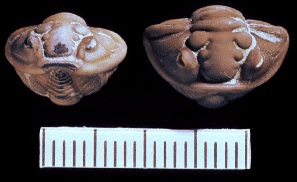
(Click on any picture to view an enlargement).
Two Enrolled Specimens (Scale in mm.)
The trilobite Flexicalymene is quite common in the Cincinnati Area. They are most often found "enrolled" (rolled in a ball). This may have been a way of defending themselves from predators (such as the Cephalopod) or from severe storms that often ravaged the Ordovician Sea. Many died in this position and were found 440 million years later as fossils. One possible reason why they are more commonly found enrolled than outstretched is that they hold together as fossils better than ones that are buried in prone positions.
A Partially Curled Flexicalymene
Some Flexicalymene are found partially curled, as in the specimen shown above.
Flexicalymene and multiple Rusophycus
Here is an astonishing piece of shale (petrified mud) showing several burrows known as Rusophycus along with a couple of the exoskeletons of the trilobite Flexicalymene. The burrows are likely to have been made by Flexicalymene trilobites. The trilobite in the center of this picture is a molt. The live trilobite shed it's shell, leaving it here in nearly perfect condition. There is another, smaller, Flexicalymene to the left of that one. You can see it better by "clicking" on the picture.
These trace fossils are harder to identify as caused by Flexicalymene, but they are arthropod tracks probably made by a trilobite. It may have been a Flexicalymene, inferred roughly from the track spread. The scale is in millimeters.
See photos of whole Flexicalymene Trilobites found on our field trips.
The Dry Dredgers is an organization of amateur geologists and fossil collectors.
More about the trilobite Flexicalymene
More about Cincinnati Trilobites
More about Identifying Trilobite Fragments
The Dry Dredgers and individual contributors reserve the rights to all information, images, and content presented here. Permission to reproduce in any fashion, must be requested in writing to admin@drydredgers.org.